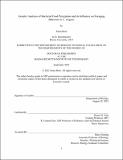| dc.contributor.advisor | Kim, Dennis H. | |
| dc.contributor.author | Boor, Sonia | |
| dc.date.accessioned | 2023-01-19T19:49:28Z | |
| dc.date.available | 2023-01-19T19:49:28Z | |
| dc.date.issued | 2022-09 | |
| dc.date.submitted | 2022-09-13T20:41:09.798Z | |
| dc.identifier.uri | https://hdl.handle.net/1721.1/147425 | |
| dc.description.abstract | The ability to adapt to changes in food conditions is critical for organismal homeostasis and survival. In this thesis, I explore the genetic and neuroendocrine mechanisms by which C. elegans evaluates bacterial food conditions and accordingly alters development and behavior. In Chapter One, I discuss the relationship between C. elegans and its bacterial diet. The influence of food on behavior suggests the presence of a gut-“brain” axis that senses and communicates information about nutritional state to the nervous system to elicit a behavioral response.
In Chapter Two, I characterize a gain-of-function allele of scd-2, the C. elegans Anaplastic Lymphoma Kinase (ALK) gene ortholog, scd-2(syb2455),which I designed based on an oncogenic mutation in ALK. While animals with loss-of-function mutations in scd-2 are dauer-formation defective, scd-2(syb2455) animals enter dauer regardless of food conditions. In Chapter Three, I report that SCD-2 also regulates the food-dependent feeding and foraging behaviors known as dwelling and roaming; scd-2(syb2455) animals roam more and scd-2 loss-of-function animals roam less than wild type. Additionally, in contrast to wild-type animals, which express the gene encoding the TGF- signaling ligand DAF-7 exclusively in the ASI chemosensory neurons, scd-2(syb2455) animals constitutively express daf-7 in both the ASI and ASJ neurons. The expression of daf-7 in the ASJ neurons drives roaming in these animals. I demonstrate that daf-7 expression in the ASJ neurons is also affected by food; ingested food in the pharynx inhibits daf-7 expression in the ASJ neurons through SCD-2 signaling. From these data we propose a positive-feedback loop that regulates roaming behavior: in the absence of ingested food, active SCD-2 induces daf-7 expression in the ASJ neurons to promote roaming, which further reduces food consumption. To further investigate how daf-7 neuroendocrine signaling responds to nutritional state, in Chapter Four I describe a screen for satiety signals using the nutritional state-dependent daf-7 expression in the ASJ neurons in males as a readout for communication along the gut-“brain” axis. This screen yielded a loss-of-function allele of che-3 and a gain-of-function allele of pdfr-1. In Chapter Five, I discuss future directions for investigating how C. elegans interacts with its food environment. | |
| dc.publisher | Massachusetts Institute of Technology | |
| dc.rights | In Copyright - Educational Use Permitted | |
| dc.rights | Copyright retained by author(s) | |
| dc.rights.uri | https://rightsstatements.org/page/InC-EDU/1.0/ | |
| dc.title | Genetic Analysis of Bacterial Food Perception and its Influence on Foraging Behavior in C. elegans | |
| dc.type | Thesis | |
| dc.description.degree | Ph.D. | |
| dc.contributor.department | Massachusetts Institute of Technology. Department of Biology | |
| dc.identifier.orcid | https://orcid.org/0000-0001-5480-3659 | |
| mit.thesis.degree | Doctoral | |
| thesis.degree.name | Doctor of Philosophy | |
